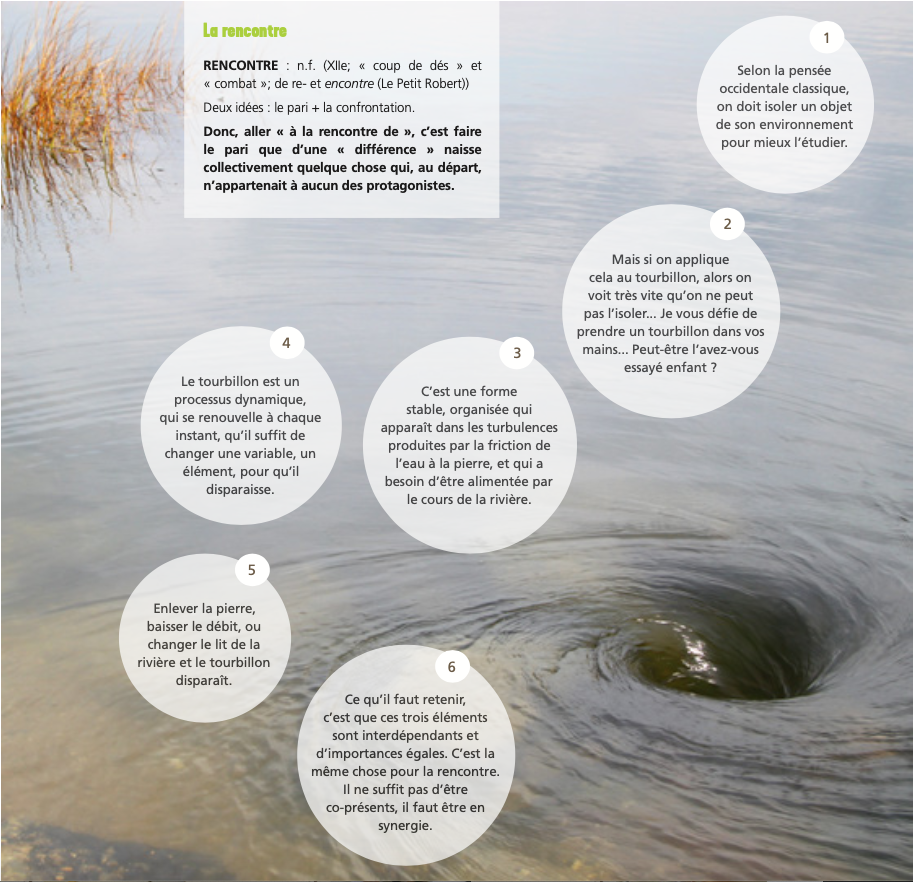Guide for Collaboration: Development and follow-up
Adopting ethical and culturally respectful behavior at all times is, of course, of great importance. Additionally, it is essential to maintain a collaborative mindset, engage in continuous reflective practice, and be aware of cultural dimensions and context: these various elements do not guarantee the success of the partnership. Simply, they are key elements of good collaborative or co-construction practice.
Here is a list of key elements to consider:
1. Ethics
Showing respect
- Understanding and applying basic rules of courtesy (to be known according to the cultural context).
- Being honest.
- Taking into account the identity, environment, experiences, values, and beliefs of Indigenous Peoples.
- Using appropriate and respectful language.
- Preserving the confidentiality of sensitive information.
2. Collaborative Spirit
- Developing and maintaining an open, curious, flexible, and partner-and community-centered mindset.
- Remembering that the partner can make their own choices without external pressure.
- Accepting being in a process of learning and creating a trust relationship built around respect and exchange in both formal and informal settings.
- Engaging in continuous reflective practice (self-evaluation) to improve the relationship.
- Remaining sensitive to the impact of context and culture on the quality of the relationship.
3. Co-Creation of a Partnership
- Fostering an egalitarian and inclusive climate that allows partners to meet and express themselves freely.
- Discussing what the partnership is and is not.
- Partnering in developing agreements on the type of partnership, approach, intentions, and objectives.
Going Further:
- Agreeing on what is and is not appropriate in the relationship (charter, code of conduct, norms, meeting procedures, project outcomes and goals, etc.).
- Agreeing on each party's responsibilities.
- Agreeing on the specific guidelines and parameters of the partnership, such as financial matters, timeline, duration, termination, confidentiality, and participation of other stakeholders.
4. Relationship
Building a relationship of mutual respect and trust.
- Seeking to understand the context, environment, experiences, values, and beliefs.
- Showing respect for the person and the community in its entirety, including its perceptions, style, and language.
- Recognizing and respecting the uniqueness of talents, ideas, and experiences in the relationship.
- Showing empathy and attention.
- Recognizing the partner’s expressions of perceptions, concerns, and suggestions.
- Being open and transparent to reveal one’s lack of knowledge and vulnerability, building a trust relationship with the partner.
5. Communication
Listening actively, with both ears and eyes: the art of listening to silence, a cultural practice among Indigenous Peoples.
- Listening actively, with both ears and eyes: the art of listening to silence, a cultural practice among Indigenous Peoples.
- Being present and available, without mental distraction.
- Staying focused, attentive, and empathetic (without judgment or criticism).
- Showing curiosity and a willingness to learn.
- Being comfortable with not knowing.
- Creating and fostering a space for silence, pause, and reflection.
- Focusing on what the partner says and does not say to fully understand what is being communicated.
- Reflecting or summarizing what has been said to ensure clarity and understanding.
- Staying attentive to energy shifts, non-verbal cues, etc.
- Integrating certain words to fully understand the meaning of what is being communicated.
- Noticing and taking note of what works well to improve communication.
- Noticing and noting new insights and discoveries.
- Responding very honestly to all questions and, if you do not know, committing to following up.
Going Further:
- Inviting the partner to express their ideas on how to move forward, what they want, or what they are capable of doing.
- Sharing observations, intuitions, and feelings that may strengthen the bonds.











